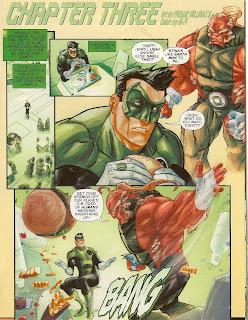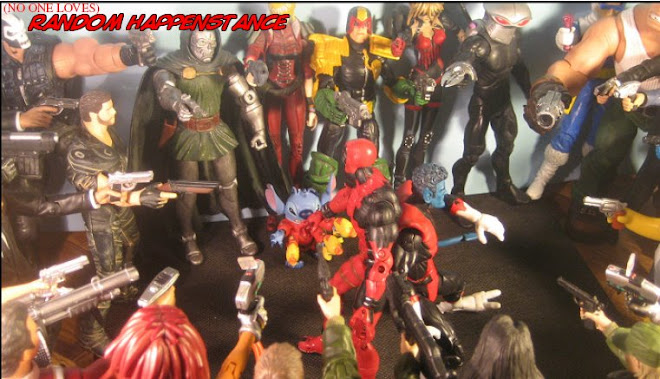Usually, when I enjoy a comic enough to add it to my pull list or follow it regularly, that’s the kiss of death and it’ll be cancelled within eight issues. Eight issues on the outside. But did I have any comics I was reading cancelled this year?...I think not! It helps that several of the titles I read are rotating limited series (like
Atomic Robo,
Baltimore,
Lobster Johnson; a lot of the Mignola books, really) and not “ongoing.”
I know
Nightcrawler is slated to end with #12, but maybe that should've been a limited as well: I’ve enjoyed it, even if it hasn’t been entirely the book I wanted; although the art is great. And I didn't see
Silver Surfer in the last solicits, although maybe Allred needed a month off.
The only book I’m reading regularly from DC isn't even a proper DC Universe book; it’s
Astro City, which is pretty consistently great. But I did see a whole slew of cancellations coming down the “New 52” pike, including
Swamp Thing,
Batwoman,
Trinity of Sin, the surprisingly readable
Red Lanterns, and both
Green Lantern Corps and
Green Lantern: New Guardians. Rumor has it, or at least vile speculation, that DC may consolidate the GL titles, perhaps into a weekly. That may not appeal to readers who are lean more to a particular character over the whole, but the books have probably been strongest when they were most interconnected.

Let’s take a look at two Green Lantern “last” issues: from 2011,
Green Lantern #67, “War of the Green Lanterns: Conclusion.” Written by Geoff Johns, pencils by Doug Mahnke, inks by Christian Alamy, Tom Nguyen, Keith Champagne, and Mark Irwin; and
Green Lantern Corps #63, “Now and Forever” Written by Scott Kolins, with art by Kolins, Joe Prado, Freddie Williams II, and Daniel HDR. Both of these are pre-New 52, but the reboot affected the GL titles much less than most other books: like the Batman books, the continuity continues, for the most part. Even though they would get new first issues out of the deal.
Johns was the primary architect of Hal Jordan’s return to prominence, as well as responsible for most of the multicolored ring corps. This issue, the GLC, led by earth boys Hal, John, Guy, and Kyle; try to free the Guardians possessed by the emotional spectrum entities controlled by Krona. Kyle frees the (so-called) New Guardians—including Sinestro, Atrocitus, and Carol Ferris—from the Book of Oa, and they get their rings back…except for Sinestro, whose yellow fear ring is taken by Krona!

Krona has Hal on the ropes, and asks why Hal defends the Guardians; who over the course of several retcons, had been revealed to have done several questionable things. Hal concedes the Guardians may need help, but he believes in the Corps. Oddly, so does Sinestro, who receives a new Green Lantern ring! Sinestro frees Hal, who then kills Krona, releasing the emotional entities and reinstating the New Guardians. Strangely, Larfleeze doesn't seem happy to get his precious orange greed ring back; but he’s not the only ungrateful one: Hal yells at Sinestro to take the green ring off, but the Guardians are somewhat dismayed that Hal managed to kill Krona, since the rings are programmed to be incapable of killing a Guardian. In short order, the New Guardians are booted off Oa; as is the “
discharged and
dismissed” Hal Jordan!

I'm mildly surprised Hal was wearing clothes before ringing up his GL suit, honestly.

The last issue of
Green Lantern Corps is a little more episodic, featuring four chapters catching up with various ring-welders in the aftermath of the “War of the Green Lanterns” crossover. And a lot of them are rather messed up, traumatized, or angry. Alpha Lantern Boodikka is brought back online, but does she have the will to go on after losing so much? With their friend Ry’jll suffering severe PTSD, G’hu and Voz wonder if they can still work for the Guardians; but Salaak sets them straight. And Kyle Rayner is accosted in the cafeteria as several GL’s are pretty sick of earthmen. But when a disaster strikes, the Lanterns come together.

Salaak’s speech is pretty great, actually; if not inspiring in a traditional sense. I suspect a lot of cops feel the same way. Boodikka isn't a character I follow, but had come a long way from her early appearances; and I think this would be Kyle last regular appearance in this book, since he’d be spun off to the New Guardians title.




















































